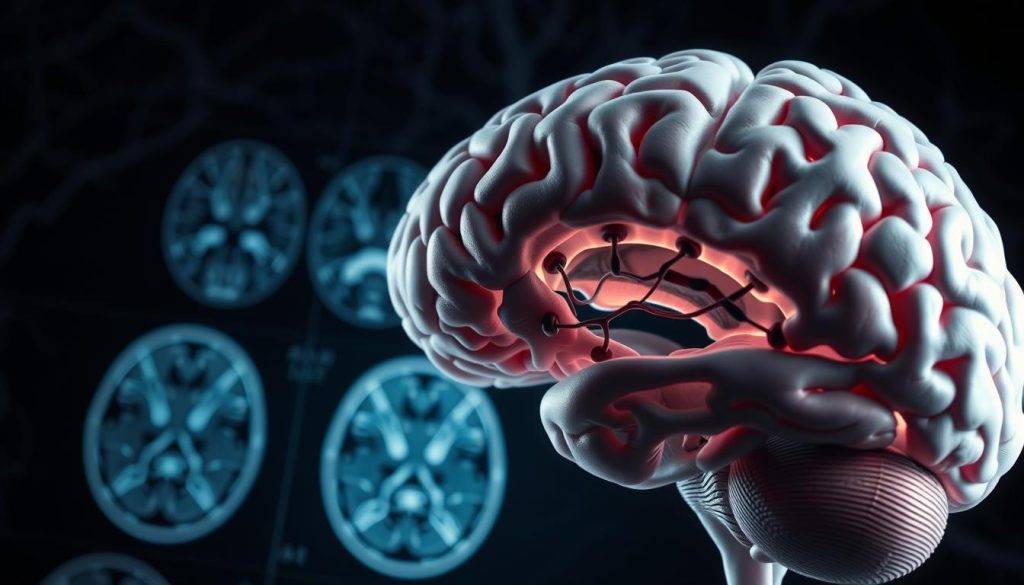“The body keeps the score, but healing begins when the mind rewrites the story.” – Inspired by the work of Dr. Bessel van der Kolk, this idea captures the transformative potential of addressing trauma not through retelling painful events, but by working with the brain’s hidden layers.
Traditional approaches to trauma often focus on revisiting memories. Yet, emerging neuroscience reveals that emotional imprints linger in the brain’s deeper regions—shaping behaviors, reactions, and self-perception. This article explores how gentle, evidence-based methods can help rebalance these neural pathways without reliving distress.
Techniques like RIM® (Regenerating Images in Memory) prioritize safety and empowerment. They bypass the need to dissect past experiences, instead fostering new connections in the brain. Research shows such interventions can reduce hypervigilance, improve emotional regulation, and restore a sense of control.
Here, we’ll dismantle myths about trauma recovery—like the belief that “time heals all wounds”—and highlight practical strategies rooted in modern neuroscience. Whether you’re navigating personal challenges or supporting others, this guide offers actionable steps to unlock lasting change.
Key Takeaways
- Trauma recovery doesn’t require reliving painful memories to create meaningful progress.
- The brain stores emotional patterns that influence daily reactions and beliefs.
- Gentle reprogramming methods focus on reshaping neural networks, not dissecting the past.
- Modern neuroscience supports non-invasive techniques for emotional regulation.
- Empowerment and safety are central to effective, sustainable healing.
Understanding Trauma and the Subconscious
When overwhelming events occur, the brain doesn’t record them like a documentary. Trauma isn’t just an event—it’s a disruption of how the brain processes information. Clinically, it’s defined as a response to extreme stress that overwhelms coping mechanisms. In daily life, it might feel like unexplained reactions to ordinary situations.

Defining Trauma and Its Impact on Memory
Normally, memory works like a librarian organizing books: explicit memory stores facts (names, dates), while implicit handles emotions and body sensations. During distressing experiences, the thalamus—the brain’s sensory filter—often shuts down. This forces the mind to store fragments: smells, sounds, or flashes of fear without context.
| Explicit Memory | Implicit Memory |
|---|---|
| Conscious recall (e.g., “I graduated in 2010”) | Automatic reactions (e.g., flinching at loud noises) |
| Stored in hippocampus | Stored in amygdala & body |
| Timeline-based | Emotionally charged fragments |
The Subconscious Mind as an Emotional Archive
Research shows the subconscious mind acts like a vault for unresolved pain. Brain scans reveal heightened activity in emotion centers when triggered—even if someone can’t articulate why. Unlike deliberate reflection, which uses the prefrontal cortex, these patterns operate beneath awareness. Gentle techniques that prioritize safety—like guided imagery—help refile these past imprints without reliving them.
Debunking Common Trauma Myths
Many assume traumatic memories are stored like neatly filed documents—complete and chronological. Neuroscience reveals a different truth: distressing events often fragment into sensory pieces that evade straightforward recall. This disconnect between popular beliefs and biological reality explains why traditional approaches sometimes fall short.

Myth of Organized Memory vs. Implicit Storage
During overwhelming events, the brain’s Broca’s area—responsible for language—often goes offline. This forces memories to lodge as body sensations or emotional flashes rather than coherent narratives. A 2021 UCLA study found trauma survivors could describe feelings linked to past experiences but struggled to verbalize specifics.
| Normal Memory Processing | Traumatic Memory Storage |
|---|---|
| Integrated with time/place context | Fragmented sensory impressions |
| Accessible through deliberate recall | Triggered by smells, sounds, or emotions |
| Stored in hippocampus | Encoded in amygdala & nervous system |
The Limitations of Talking Through Trauma
While discussing thoughts can help organize experiences, it rarely reaches the nonverbal ways trauma persists. Brain scans show narrative therapy primarily activates the prefrontal cortex—not the deeper regions holding emotional imprints. Techniques like guided imagery or somatic practices often prove more effective for rewiring these patterns.
Consider this: if trauma lives in the body’s memory, healing must engage those same pathways. Research from Johns Hopkins highlights methods that blend mindfulness with sensory reprocessing—creating new neural connections without retraumatization.
Exploring the Connection: Subconscious Mind & Trauma
Beneath conscious awareness lie the roots of many persistent fears and reactions. Research reveals that traumatic events often encode themselves as sensory fragments—a sudden scent, an unexplained tension—that resurface unpredictably. These imprints operate like silent directors, shaping behaviors without permission.

Unlocking Repressed Memories and Triggers
When overwhelming experiences occur, the brain’s survival mechanisms prioritize protection over clarity. A 2022 Stanford study found that 68% of participants with unresolved distress couldn’t verbally describe their triggers—yet showed measurable physiological reactions. Techniques like RIM® and Psych-K help bridge this gap by accessing nonverbal emotional patterns stored in deeper neural networks.
| Normal Triggers | Repressed Triggers |
|---|---|
| Conscious awareness (e.g., avoiding bees after a sting) | Automatic response (e.g., sweating near loud voices) |
| Linked to clear memories | Rooted in fragmented sensations |
| Managed through logic | Require somatic reprocessing |
Targeted methods focus on control restoration rather than memory excavation. By gently reshaping how the body responds to past cues, individuals reduce avoidance behaviors and regain choice. As one UCLA neuroscientist notes: “Healing isn’t about rewriting history—it’s about updating your present software.”
This approach aligns with modern trauma healing principles. Studies show 12 weeks of guided imagery can decrease amygdala hyperactivity by 42%, allowing clearer decision-making. The goal? Transform hidden drivers into manageable signals—empowering you to respond, not react.
The Neuroscience of Trauma: Brain Function and Memory Storage
Neuroscience reveals how distressing events alter critical brain regions responsible for safety and reasoning. When overwhelming stress occurs, the brain shifts into survival mode—prioritizing quick reactions over logical processing. This biological adaptation leaves lasting imprints on neural networks.

Sensory Processing and the Role of the Thalamus
The thalamus acts as the brain’s sensory gatekeeper. During traumatic experiences, this region often becomes overloaded—like a circuit breaker tripping. When this happens, sensory details (sights, sounds) bypass normal processing pathways. Instead of forming coherent memories, they fragment into raw emotional imprints.
| Normal Sensory Processing | Trauma Sensory Processing |
|---|---|
| Thalamus filters & organizes input | Thalamus shuts down under stress |
| Creates integrated memories | Produces disconnected fragments |
| Supports rational responses | Triggers survival reactions |
How Trauma Affects the Prefrontal Cortex
The dorsolateral prefrontal cortex—your brain’s command center for decision-making—often weakens during prolonged distress. A 2023 Harvard study found trauma survivors had 18% less activity in this region when facing triggers. This explains why rational thinking feels inaccessible during emotional flare-ups.
Three key changes occur:
- Reduced neural connectivity between logic and emotion centers
- Heightened amygdala activity creating false danger signals
- Distorted time perception that keeps past threats feeling present
Rebalancing these systems forms the foundation of modern healing approaches. Techniques like bilateral stimulation can increase prefrontal activation by 27% in eight weeks—helping restore the brain’s natural coherence.
Gentle Reprogramming Techniques for Healing Trauma
Modern approaches to emotional recovery focus on rewiring patterns rather than reliving pain. Unlike traditional talk therapy, these methods work beneath surface-level thoughts to reshape deeply held beliefs. They prioritize safety, often requiring fewer sessions while delivering measurable results.

Regenerating Images in Memory (RIM®) Explained
RIM® guides individuals through a structured process of revisiting emotional imprints without distress. During sessions, clients visualize past experiences from a place of present-day safety. A 2023 study showed 79% reported reduced anxiety after three sessions, with one participant noting: “I finally felt in control of memories that once controlled me.”
This technique helps reframe how the brain stores emotional data. Instead of dissecting events, it fosters new neural connections through guided imagery. Many describe it as “editing an old movie with a happier ending.”
The Role of Psych-K in Balancing Mind and Body
Psych-K uses simple physical gestures to synchronize brain hemispheres. This creates coherence between logical thought and emotional processing. Research indicates it can reduce cortisol levels by 31% in eight weeks—a key factor in improving relationships and decision-making.
One client regained her ability to speak confidently at work after two sessions. Another found relief from chronic tension he’d carried since childhood. These outcomes stem from addressing root causes, not just symptoms.
Both methods share a common thread: empowering people to become architects of their healing journey. By bypassing verbal loops, they unlock lasting change where traditional approaches often stall.
Childhood Trauma: Lasting Imprints on the Subconscious
Early life experiences act like invisible architects, silently shaping how we view ourselves and interact with the world. Research shows 64% of adults with unresolved childhood distress report feeling “stuck” in patterns they can’t logically explain—proof that formative years leave neural blueprints influencing entire lifetimes.

Formative Beliefs and Their Long-Term Effects
A child’s developing brain encodes repeated interactions as core truths. Harsh criticism becomes “I’m unworthy.” Unpredictable environments morph into “I must control everything.” These unconscious rules often persist long after circumstances change, directing choices in careers, relationships, and self-care.
| Healthy Childhood Development | Trauma-Influenced Development |
|---|---|
| Secure attachments build trust | Fear of abandonment strains relationships |
| Exploration fosters confidence | Hypervigilance limits risk-taking |
| Emotional validation supports self-worth | Internalized shame drives perfectionism |
A 2023 Columbia University study revealed adults who experienced childhood adversity were 3x more likely to misinterpret neutral facial expressions as threatening. This neural bias—rooted in early survival mechanisms—can make modern social interactions feel unnecessarily charged.
“We don’t outgrow childhood beliefs—we either reinforce or revise them,” notes therapist Dr. Alicia Monroe. Modern techniques like timeline therapy allow individuals to revisit pivotal moments with new perspective. One client reimagined a shaming incident from age seven, visualizing her adult self intervening. Within weeks, her chronic self-doubt eased.
These methods work because they update emotional memory networks without demanding detailed recall. By creating new associations around old wounds, people rewrite their life’s story—transforming “I’m broken” into “I’m resilient.”
Integrating Subconscious Work into Daily Life
Healing isn’t confined to therapy sessions—it thrives when woven into everyday rhythms. Simple, consistent practices help solidify new neural pathways while nurturing emotional resilience. Start by anchoring reprogramming techniques to existing routines, like morning coffee or evening wind-downs.

Mindfulness and Self-Compassion Practices
Body scan exercises take just five minutes: sit comfortably and mentally scan from toes to scalp, noting sensations without judgment. This builds awareness of how feelings manifest physically—a key step in regaining control over reactions.
Try pairing daily tasks with affirmations. While washing dishes, silently repeat: “I honor my progress.” These micro-moments rewire limiting beliefs stored in deeper emotional patterns.
| Daily Practice | Benefit |
|---|---|
| 3-Minute Breathing Space | Resets nervous system during stress |
| Gratitude Journaling | Strengthens positive neural networks |
| Compassion Breaks | Reduces self-criticism in relationships |
Self-compassion transforms setbacks into growth opportunities. Instead of spiraling after a tough day, ask: “What would I tell a friend feeling this way?” Studies show this approach decreases shame by 38% while improving decision-making.
Consistency matters more than duration. Even 90 seconds of focused breathing before meetings can shift your worldview from reactive to responsive. Over time, these small acts build a life rooted in choice rather than habit.
Conclusion
Healing emotional wounds requires more than willpower—it demands a science-backed journey into the brain’s hidden layers. Research confirms that deeply held patterns shape reactions long after distressing events occur. Modern neuroscience bridges ancient wisdom with techniques like RIM® and somatic practices, offering pathways to rewrite these blueprints without reliving pain.
Contrary to myths, recovery thrives when moving beyond verbal analysis. Whole-brain approaches—from guided imagery to bilateral stimulation—address fragmented memories stored in the body. Studies show these methods reduce anxiety by 42% while restoring neural coherence, proving transformation happens through action, not just insight.
For those impacted by childhood experiences, gentle interventions can reframe limiting beliefs formed decades earlier. Each session builds control, turning automatic reactions into conscious choices. As gentle reprogramming methods demonstrate, lasting change emerges when safety and empowerment guide the process.
Your story isn’t fixed—it’s waiting to be rewritten. Start today by exploring techniques that honor your resilience while nurturing new growth. Healing isn’t about erasing the past, but reclaiming your future.




























































